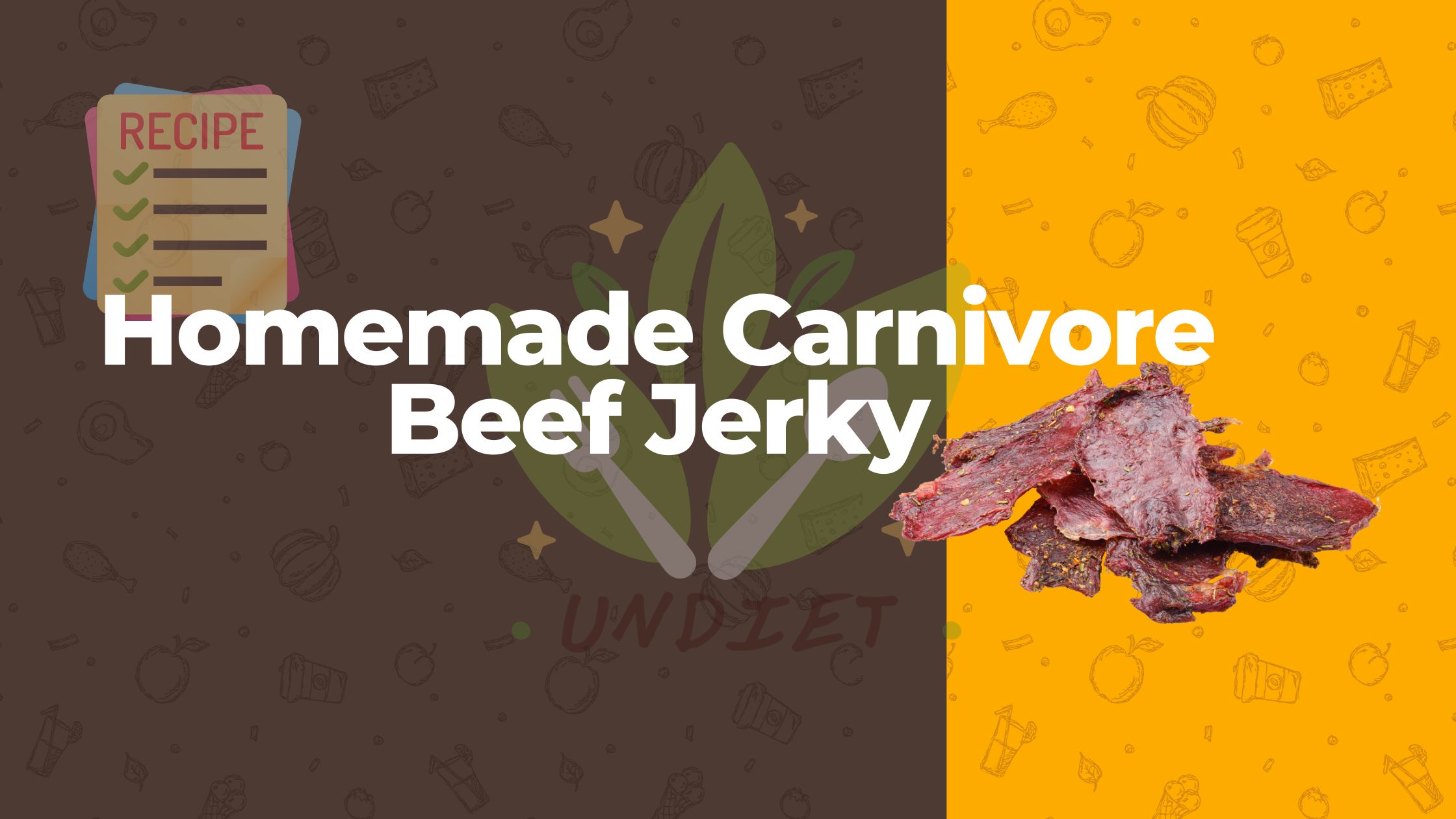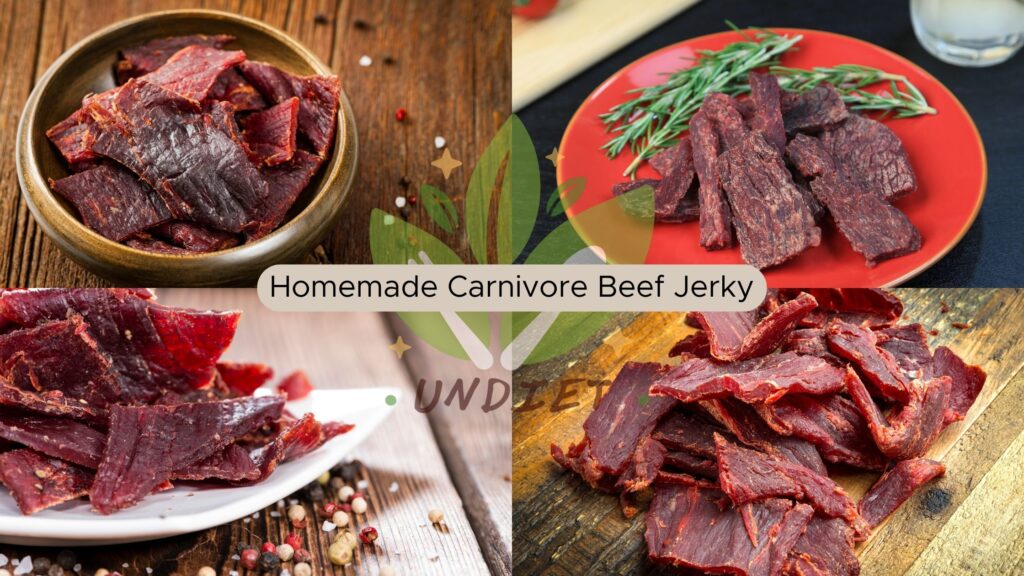Homemade Carnivore Beef Jerky: The Ultimate Guide for You

Welcome to the world of handmade carnivore beef jerky, where creativity and tradition converge to take your taste senses on a remarkable culinary adventure. It can seem tough to find a healthy snack that is still decadent in today’s hectic world. However, what if I told you that you can make a snack in your kitchen that not only fulfills your want for meat but also improves your cooking skills? More than just a culinary delight, homemade carnivore beef jerky is a celebration of simplicity, an ode to the undiluted, raw essence of meat, and an endorsement of your culinary prowess.
Come along as we reveal the techniques, tastes, and pure fun of making your own Carnivore Beef Jerky from scratch. Learn about the science of drying, the art of marinating, and the creative freedom to customize your jerky to its absolute best. Prepare yourself for a delicious journey that will transform the way you enjoy snacks and leave you wanting more. So put on your apron and let’s enter the heart of this carnivorous treat, where the ordinary becomes spectacular and your kitchen becomes a jerky-making haven. Now let’s off on our jerky adventure!
What is Carnivore Beef Jerky?
A delicious meat snack that has become very popular among meat lovers and people on low-carb or carnivorous diets is Carnivore beef jerky. Carnivore beef jerky is all about pure, unadulterated meat goodness, unlike other jerky selections that may contain extra sweeteners or preservatives. Here’s a closer look at what makes beef jerky from Carnivore distinct:
Preparation Methods
Slicing lean beef slices into thin strips is a simple step in the preparation of carnivore beef jerky. The meat’s qualities are then enhanced without sacrificing their simplicity by seasoning these strips with a blend of salt, herbs, and natural spices. The meat is dehydrated or smoked after it has marinated for a while, eliminating moisture and producing a chewy, tasty jerky in its place.
Important Ingredients
Carnivore beef jerky’s simplicity is what makes it so beautiful. Typically, the essential components consist of:
- Lean Beef Cuts: Lean beef cuts like flank, round, or sirloin are typically used to make carnivore beef jerky, guaranteeing a high-protein snack with minimal fat.
- Natural Spices and Herbs: To enhance the meat’s flavor profile, seasonings such as cayenne pepper, onion powder, garlic powder, and black pepper are frequently utilized.
- Season: In addition to improving the flavor, salt serves as a natural preservative that prolongs the shelf life of the jerky without the need for added chemicals.
Simplicity and Natural Flavors
The simplicity of Carnivore Beef Jerky is one of its most alluring features. There aren’t any laborious steps or extra substances needed. Rich, delicious, and gratifying jerky is produced when the natural flavors of premium beef are paired with well-selected seasonings. It’s a guilt-free treat for meat lovers that honors the quality of unadulterated, pure beef.
The appeal of carnivore beef jerky is found in its capacity to evoke the instinctive joy that comes from consuming meat in its most basic form. It’s a celebration of simplicity that brings out the natural flavors of beef and offers people who value the goodness of pure meat a quick, high-protein snack.
Benefits of Carnivore Beef Jerky
In addition to being a tasty snack, carnivore beef jerky has many nutritional advantages that make it a favorite among people who are concerned about their health. Here’s why the nutritional value of carnivore beef jerky is superior:
High Level of Protein
Protein-rich Carnivore beef jerky is a powerful snack. It’s a great source of vital amino acids because it’s packed full of high-quality protein. For the maintenance of the organism as a whole, muscular growth, and healing all depend on protein. Carnivore beef jerky is a handy and portable source of protein for people who exercise frequently or lead active lifestyles.
Natural Low-Carb
Carnivore beef jerky is a game-changer for people on low-carb or ketogenic diets. Carnivore beef jerky has fewer carbohydrates than many typical snacks, so people may indulge in their appetites without worrying about going over their carbohydrate intake limit. It’s a wise option for those trying to stay in ketosis or limit their carb intake because of its low-carb nature.
Fits into Various Diets:
Carnivore beef jerky is very adaptable to a wide range of dietary plans.
- Dietary Keto: The principles of the ketogenic diet, which emphasize high fat, moderate protein, and low carbs, are well aligned with carnivore beef jerky. Due to its low carbohydrate content, it’s a great snack for people trying to enter and stay in ketosis and helps them stick to their daily carbohydrate intake guidelines.
- Paleolithic (Paleo) Diet: The goal of the Paleolithic diet, sometimes referred to as the Paleo diet, is to eat foods that our ancestors would have eaten in the Paleolithic period. Because carnivore beef jerky is a naturally occurring meat product with minimum processing, it is a perfect fit for this diet. As a grain-free, dairy-free, and artificial additive-free snack, it fits the Paleo diet well.
Multipurpose Snack Choice
The adaptability of carnivore beef jerky is noteworthy in addition to its nutritious advantages. Carnivore beef jerky is a great option if you’re on a hiking route, in the gym, or just need a quick and filling snack at work. Its portable and lightweight design makes it easy to transport, and since it doesn’t need to be refrigerated, you may have a snack full of protein whenever and wherever you like.
Carnivore beef jerky is ideal for various dietary preferences due to its high protein level and low carbohydrate content. It also offers a multitude of nutritional benefits. Its suitability for a range of diets, including paleolithic and ketogenic diets, makes it a preferred choice for anybody looking for a tasty, high-protein, and healthful snack.
Choosing the Right Beef for Carnivore Beef Jerky
Choosing the appropriate beef cut is essential for creating the ideal carnivore beef jerky. The flavor and texture of your jerky can be greatly influenced by the type of meat you choose. The following advice will help you select the best cuts so that your jerky is soft and flavorful:
Highlighting Trim Cuts:
Choose for lean beef cuts like flank, round, or sirloin. These slices are perfect for producing jerky because they are low in fat. Lean cuts guarantee that your jerky stays fresher for longer because fat deteriorates quickly. Before slicing the meat into thin strips, remove any exposed fat.
Take a Look at Marbling
The term “marbling” describes the tiny fat striations seen inside the meat’s muscular fibers. Even though you want lean beef, your jerky will taste better and be more juicy if there is just a little bit of marbling. Suggested marbling indicates a good balance between meaty flavor and suppleness in cuts.
High-Grade Beef Purchasing
Select fresh, premium meat from reliable suppliers. Go to your neighborhood farmers’ markets, butcher shops, or specialized meat stores to speak with informed employees about your jerky needs. The best taste and texture of your jerky are guaranteed when you use premium beef. Furthermore, for a more organic and nutrient-dense jerky, think about grass-fed or organic beef choices.
Determining Appropriate Slices
Think about cuts of beef that are simple to cut thinly against the grain when choosing meat for jerky. The finished dish will have a chewable texture thanks to this slicing technique. Because they slice uniformly thanks to their grain structure, flank, sirloin, and round steaks are great options. Ask the butcher for help slicing the meat if you’re not sure how to do it. They can chop the beef to the proper thickness for making jerky.
Examining the Meat
Make sure the meat is fresh and devoid of any discoloration, odors, or over-wetness. The secret to making delicious and safe jerky is freshness. For optimal results, try to purchase the beef on the day you intend to prepare the jerky.
You may select the ideal meat for your carnivore beef jerky with confidence if you adhere to these recommendations. Lean slices are preferred, marbling adds flavor, premium beef is preferred, appropriate cuts are chosen for ease of slicing, and freshness is always the top priority. For meat lovers, your homemade carnivore beef jerky will be a delicious and fulfilling treat if you choose the proper beef.
Making Carnivore Beef Jerky at Home: A Step-by-Step Guide

Making carnivore beef jerky at home is a tasty and satisfying project. You can make jerky that is devoid of additives and bursts with natural flavors with just a few simple ingredients and patience. This comprehensive, step-by-step tutorial will assist you in becoming an expert maker of carnivore beef jerky at home:
Ingredients:
- 2 lbs (approximately 900g) of lean beef (such as sirloin, round, or flank steak)
- 1/4 cup soy sauce or coconut aminos
- 2 tablespoons Worcestershire sauce
- 1 teaspoon black pepper
- 1 teaspoon garlic powder
- 1 teaspoon onion powder
- 1/2 teaspoon cayenne pepper (adjust to taste for spiciness)
Equipment:
- Sharp knife for slicing the meat thinly
- Large resealable plastic bag or glass dish for marinating
- Mixing bowls
- Measuring spoons
- Dehydrator or oven with a low-temperature setting
- Parchment paper or non-stick drying sheets
Guidelines:
- Get the beef ready: – To make the beef firmer and easier to slice thinly, put it in the freezer for about half an hour. Cut the beef against the grain into strips that are between 1/8 and 1/4 of an inch thick, and remove any visible fat.
- Get the marinade ready: – Mix the Worcestershire sauce, cayenne pepper, black pepper, onion powder, garlic powder, and soy sauce in a mixing bowl. To make the marinade, thoroughly mix.
- Let the Meat Marinate: – The beef strips should be sliced and placed in a glass dish or resealable plastic bag. Make sure every strip of meat is equally coated when you pour the marinade over it. For optimal flavor absorption, cover the dish or seal the bag and refrigerate for at least two hours or overnight. For the marinade to be distributed evenly, turn the bag from time to time.
- Preheat the Oven or Dehydrator: – Turn the oven down to the lowest setting (typically about 170°F or 75°C) or preheat your dehydrator to 160°F (70°C). When using an oven, slightly open the door to let moisture out.
- Arrange the Jerky Strips – Use parchment paper or non-stick drying sheets to line the dehydrator trays. If using an oven, put the marinated beef strips in a single layer, making sure they don’t overlap or touch, on a wire rack set over a baking sheet.
- Dry or Dehydrate in the Oven: – Dry the beef strips in the oven for four to six hours, or until they are chewy and dry but not brittle. If using an oven, check the jerky after three hours and keep drying it until the desired consistency is achieved. For even drying, rotate the pans or sometimes flip the strips.
- Cool and Store: – Allow the jerky to cool fully before putting it in storage. Use paper towels to gently wipe away any extra oil. For up to two weeks, keep the carnivore beef jerky at room temperature in sealed containers or resealable bags. You can freeze or refrigerate the jerky to extend its shelf life.
Enjoy the protein-rich snack or tasty addition to your favorite recipes which is your handmade carnivore beef jerky. To create the ideal jerky recipe, try out several spice combinations!
Flavor Variations of Carnivore Beef Jerky: Spice Up Your Experience
Because carnivore beef jerky is so adaptable, you may try out different flavors to see what suits your palate best. Everybody may find their flavor combination, be it a hint of sweetness, a smokey scent, or a spicy kick. Here are three delectable recipes for carnivore beef jerky to get your creative juices flowing:
1. Spicy Carnivore Beef Jerky:
Ingredients:
- 2 lbs (approximately 900g) lean beef, thinly sliced
- 1/4 cup soy sauce or coconut aminos
- 2 tablespoons hot sauce (adjust to taste for desired spiciness)
- 1 teaspoon cayenne pepper
- 1 teaspoon smoked paprika
- 1/2 teaspoon garlic powder
- 1/2 teaspoon black pepper
Instructions:
- Simply follow the previous section’s instructions to make jerky, but replace the marinade components with the ones mentioned above.
- To allow the spicy spices to seep into the steak, marinade it for at least two hours or overnight.
- Make sure the marinated beef has the right amount of spice and chewiness by drying or dehydrating it according to the directions.
2. Smoky Carnivore Beef Jerky:
Ingredients:
- 2 lbs (approximately 900g) lean beef, thinly sliced
- 1/4 cup soy sauce or coconut aminos
- 2 tablespoons liquid smoke
- 1 teaspoon smoked paprika
- 1 teaspoon garlic powder
- 1/2 teaspoon black pepper
- 1/2 teaspoon onion powder
Instructions:
- To make a flavorful, smokey combination, combine the marinade ingredients in a mixing bowl and whisk thoroughly.
- For maximum flavor penetration, marinate the beef strips for two hours or overnight.
- To attain an ideal harmony of softness and smokeiness, dehydrate or dry-cure the marinated beef.
3. Teriyaki Carnivore Beef Jerky:
Ingredients:
- 2 lbs (approximately 900g) lean beef, thinly sliced
- 1/4 cup soy sauce
- 2 tablespoons honey or a low-carb sweetener
- 1 teaspoon minced fresh ginger
- 1 teaspoon minced garlic
- 1/2 teaspoon sesame oil
- 1/2 teaspoon black pepper
Instructions:
- To make the teriyaki marinade, combine the soy sauce, sesame oil, honey (or sweetener), minced ginger, minced garlic, and black pepper in a mixing bowl.
- To allow the teriyaki flavors to seep into the flesh, marinate the beef strips for at least two hours, or perhaps overnight.
- The marinated beef should be dried or dehydrated until it acquires a chewy, delicious texture that perfectly captures the flavor of teriyaki.
Feel free to use your imagination when creating carnivore beef jerky recipes! Try a variety of spices, herbs, and sauces to find flavor combinations that are new and exciting to your palate. There are countless options available, depending on whether you like a strong, spicy profile or a delicate, smoky scent. Remember that the fun part of making your jerky is that you can customize the tastes to your preference.
So choose your preferred ingredients and set out to create some jerky. You never know—you might find your new go-to recipe for carnivore beef jerky and be left wanting more! Cheers to producing jerky!
Carnivore Beef Jerky Storage and Packaging
Carnivore beef jerky can keep its mouthwatering flavors and chewy texture for a long time if preserved correctly. The following are some crucial pointers for preserving and imaginatively presenting your homemade carnivore beef jerky:
Appropriate Storage Techniques:
- Airtight Jars: Once the jerky has completely cooled, keep it sealed in containers to keep out air. For this use, resealable plastic bags or mason jars are ideal. To preserve freshness, remove any extra air before sealing.
- Using a vacuum sealer: Purchasing a vacuum sealer can greatly increase the jerky’s shelf life. Air is removed from vacuum-sealed pouches, preventing oxidation and maintaining the integrity of the jerky. This is a particularly helpful way if you want to gift or keep jerky for a long time.
Freezing and Refrigeration
- Freezing: Jerky that has been properly preserved can keep for a few weeks at room temperature, but refrigeration will keep it even fresher longer. If you will be using homemade jerky for a longer amount of time, it should be refrigerated.
- Drying out: Freeze your jerky to preserve it for a long time. Divide it into smaller portions, seal it tightly with a vacuum sealer, or transfer it to airtight containers, and keep chilled. Jerky that is frozen can keep its flavor for several months.
Ingenious Packaging Concepts
- Customized Mason Jars: For a meaningful gift, fill small mason jars with jerky, tie personalized labels or ribbons around each jar, and include the recipient’s name.
Gift Baskets with Jerky: Assemble jerky varieties in attractive baskets with coordinating products such as cheese, dried fruits, and nuts to create gift baskets with a jerky theme. - Homemade Jerky Containers: Make your packaging out of butcher or brown parchment paper. For a nice and rustic presentation, cut them into squares, wrap each piece of jerky, and tie the ends with string.
- Packs of Jerky Samples: Make a variety of jerky tastes and place them in little bags that can be sealed. Pack these packs into a pretty box to make a sampler set that is ideal for giving to loved ones.
Extra Advice
- Titling: If you’re giving jerky as a present or keeping various flavors in storage, think about writing the flavor and preparation date on the label of each box.
- Steer clear of moisture: Jerky suffers from moisture. Before storing, make sure the jerky is totally dry, and keep it out of damp conditions.
- Use Within Allotted Time: For the greatest freshness and flavor, homemade jerky should be eaten within a few months, even after properly stored.
You can get the most out of your carnivorous beef jerky by using these storage techniques and packaging suggestions, whether you’re enjoying it for yourself or giving it to others as a thoughtful, handcrafted present. Happy giving and munching!
Conclusion: Embrace the Carnivore Beef Jerky Experience
We’ve delved into the world of carnivore beef jerky on this tasty adventure, discovering its distinct appeal to both meat lovers and those on a health-conscious diet. Carnivore beef jerky is a testament to the genuine satisfaction of indulging in unadulterated meat, from its simplicity and natural flavors to its outstanding nutritional profile.
Carnivore beef jerky has many advantages; it’s a high-protein snack that works well with a variety of diets, such as paleolithic and ketogenic diets. Because of its adaptability, it may be made into a wide variety of flavors, from teriyaki to spicy and smokey, to suit a wide range of palates.
Savor the Joy of Making Your Own Jerky:
Making carnivore beef jerky at home is an experience that links you to the primordial joy of enjoying meat in its most basic form, rather than just a gourmet venture. It’s a very gratifying and enjoyable process to marinate, dry, and then savor the final product.
A Request for Action
You have the opportunity to explore the world of homemade carnivore beef jerky now! I hope you will give these recipes a try, create your own original taste combinations, and take your kitchen on a jerky-making journey. You can create any flavor that appeals to your palate because your inventiveness is limitless.
But that’s not all; I cordially welcome you to join our active group of carnivores. In the space provided for comments below, please share your stories, techniques, and taste discoveries. Together, our shared love of meat and the excitement of trying new foods will create a network where we can all get inspiration and knowledge from one another.
So, why do you hesitate? After gathering your ingredients and heating up your oven or dehydrator, your kitchen will smell like carnivore beef jerky. Cheers to the joy of enjoying this healthy, homemade treat and the fascinating food adventures that lie ahead. Cheers to producing jerky!
Frequently Asked Questions about Carnivore Beef Jerky
Is carnivore beef jerky suitable for people following a low-carb or ketogenic diet?
Yes, for people on a low-carb or ketogenic diet, carnivore beef jerky is a great snack option. It is low in carbohydrates, which makes it a tasty, high-protein option for those trying to cut back on their intake of carbohydrates.
How long does homemade carnivore beef jerky last?
Homemade carnivore beef jerky kept in an airtight jar will keep for up to two weeks at room temperature. It has a longer shelf life when chilled. The jerky’s freshness can be maintained for several months by freezing it for longer storage.
Can I make carnivore beef jerky without a dehydrator?
Carnivore beef jerky is indeed possible to produce without a dehydrator. An alternative would be to use an oven that has been set to its lowest temperature. To enable moisture to escape, just arrange the marinated beef strips on a wire rack over a baking pan and bake with the oven door slightly ajar. After the strips acquire the appropriate texture, rotate them periodically.
Is it possible to make carnivore beef jerky without soy sauce or Worcestershire sauce for dietary reasons?
Certainly. Although Worcestershire sauce and soy sauce are often used ingredients, you can use coconut aminos as a soy sauce substitute. To fit your dietary requirements, you may also experiment with other gluten-free, low-carb sauces or even make your flavor blend with salt, pepper, and other spices.
Can I use different types of meat to make carnivore jerky, or is it primarily made with beef?
Although beef is the most common option, you can also make carnivore jerky with venison, turkey, or pig. Selecting lean cuts and using the same marinating and drying procedure are crucial. Your palate will be treated to a diversity of flavors as each variety of meat contributes its distinct flavor to the jerky.
How do I know if the carnivore beef jerky is properly dried and safe to eat?
Carnivore beef jerky that has been properly dried should be chewy and firm, but not crumbly. The jerky needs to be completely dehydrated to eliminate any moisture before it is safe to consume. A component should crack slightly but not break when bent. To avoid moisture absorption, which could cause spoiling, store the jerky in airtight containers as well.
Related Recipes and Resources
If you’ve enjoyed making carnivore beef jerky and want to explore more recipes and seasonings to elevate your jerky-making skills, here are some useful resources:
- Homemade Teriyaki Sauce Recipe: Discover how to create a delicious homemade teriyaki sauce that’s ideal for adding an Asian flair to your carnivorous beef jerky.
- Spicy Jerky Seasoning Blend: Add some flavor to your jerky by using this homemade spice combination. This recipe gives your carnivorous beef jerky the ideal amount of flavor and spice.
- Herbs and Spices for Jerky Making: Seek out an extensive reference to different herbs and spices that can improve the flavor of your jerky. Try out several combinations to develop your own jerky flavor.
- Smoking Techniques for Jerky: This tutorial provides advice and ways for smoking jerky using various wood chips and procedures if you want to give your carnivore beef jerky a smokey flavor.
- Creative Jerky Recipes eBook: Get the eBook with over 50 creative jerky recipes. With jerky recipes that range from robust and spicy to sweet and savory, this eBook has something for every pallet.
By looking through these materials, you can increase the variety of jerky you can make and get ideas for flavorful, texture-driven carnivore beef jerky. Enjoy your experiments!






